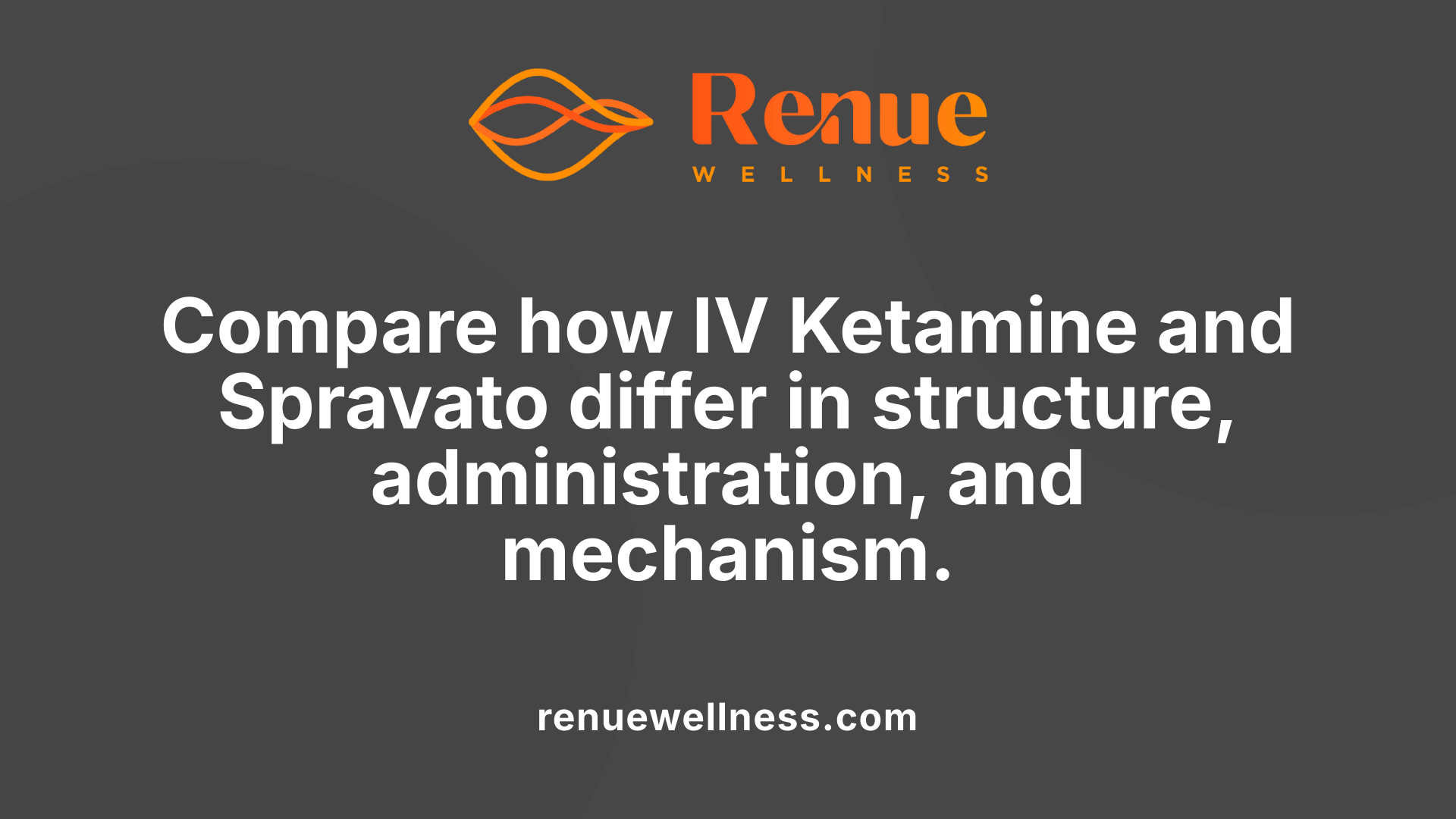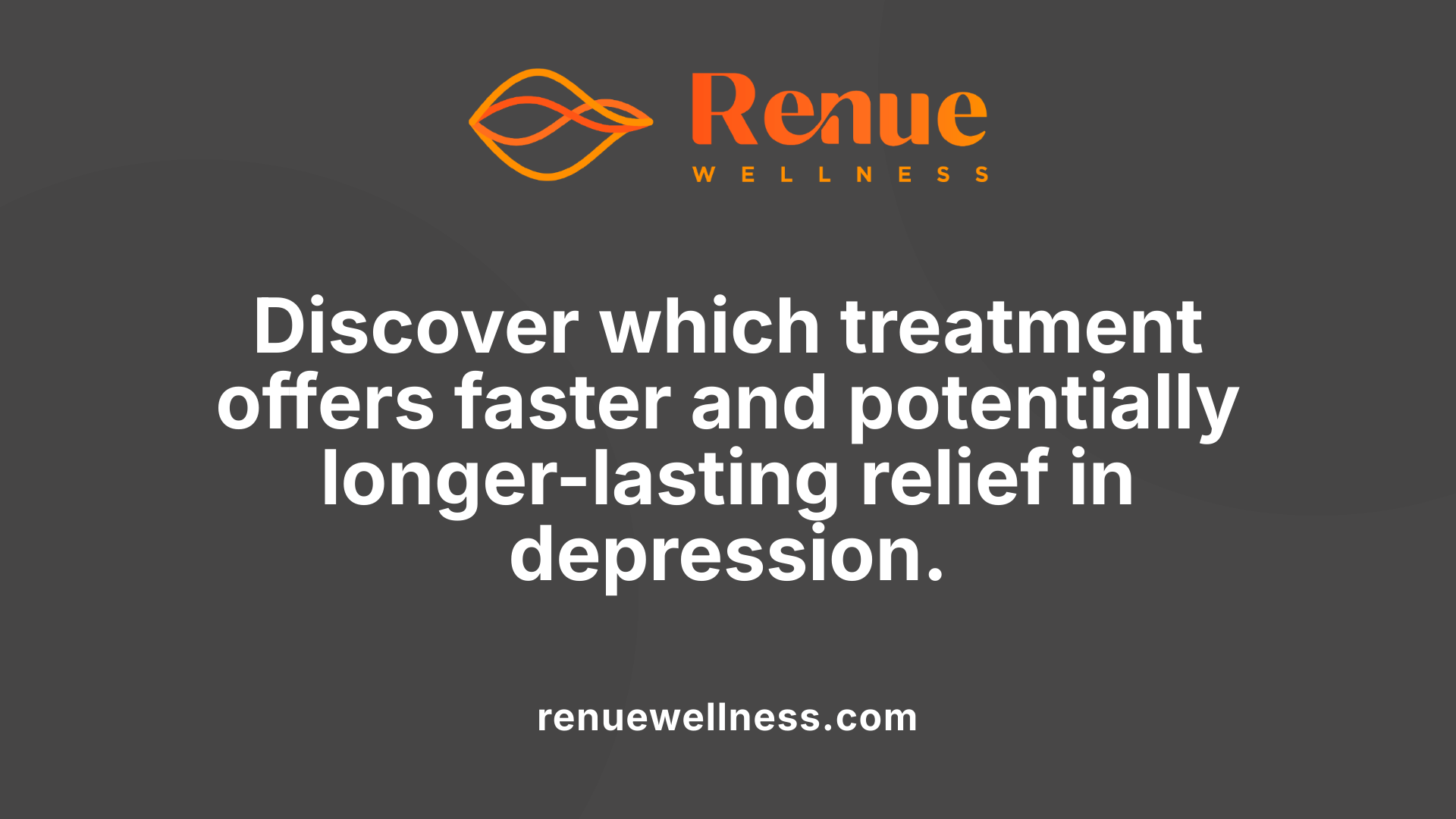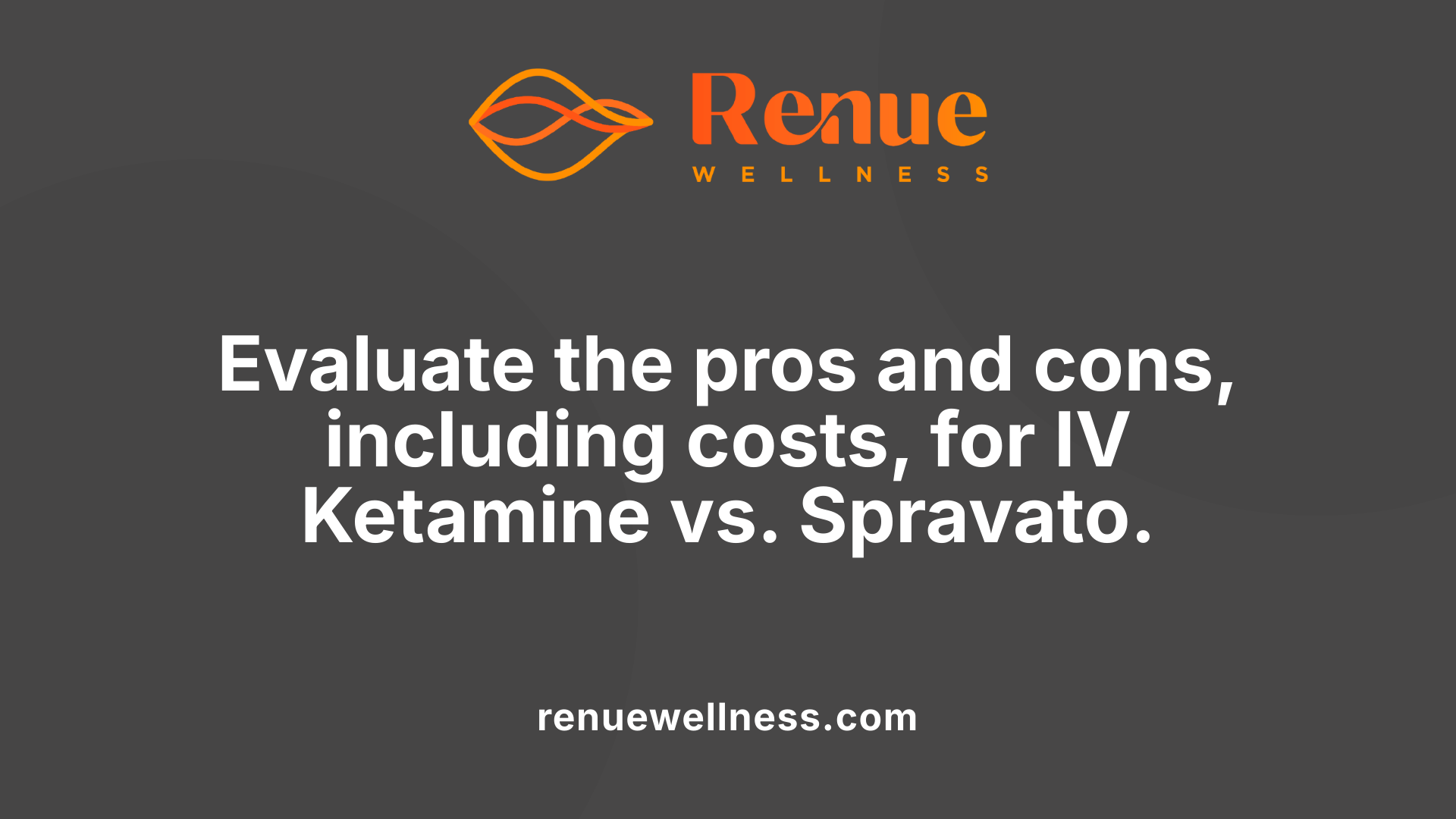IV Ketamine vs. Spravato: Which Is More Effective?


July 17, 2025
Understanding Rapid-Acting Antidepressants: IV Ketamine and Spravato
Treatment-resistant depression (TRD) poses a significant challenge in mental health, demanding fast and effective solutions. Over recent years, ketamine-based therapies, including intravenous (IV) ketamine and Spravato (esketamine), have gained prominence due to their rapid antidepressant effects. This article examines the differences, efficacy, safety, costs, and suitability of these two treatments, providing insights to guide optimal patient choices.
Structural and Pharmacological Differences

What are the differences in structure, mechanism, and administration between IV Ketamine and Spravato (esketamine)?
IV ketamine is a racemic mixture, meaning it contains both R- and S-enantiomers of the molecule. It is administered directly into the bloodstream through an intravenous infusion, which allows for fast absorption and a rapid onset of action. This method offers precise control over dosing, making it adjustable to each patient's needs. IV ketamine infusions are typically given over 40-60 minutes, and this approach has a long history of use, primarily as an anesthetic.
Spravato, on the other hand, consists of esketamine, the S-enantiomer of ketamine. It is more potent at NMDA glutamate receptors—up to 2-3 times higher affinity—permitting lower doses. Approved by the FDA in 2019, Spravato is administered as a nasal spray under strict medical supervision. The nasal spray is usually given twice a week at the beginning, with sessions lasting about two hours, where patients are monitored for side effects.
Both medications influence the glutamate system by targeting NMDA receptors, which boosts neuroplasticity and helps repair brain circuits affected by depression. However, esketamine’s higher potency means it may induce fewer side effects at lower doses, making it a more convenient and less invasive option.
In summary, the primary distinctions lie in their structural composition—racemic mixture versus pure enantiomer—and their modes of delivery—IV infusion versus nasal spray. The intravenous route allows real-time dose adjustments and quick effects, whereas the nasal spray offers a more straightforward, clinic-based administration with regulatory oversight. Both treatments require monitoring for side effects such as dissociation, blood pressure changes, and dizziness, but the method of administration influences their safety profiles and patient experience.
Efficacy in Clinical Studies and Patient Outcomes

What does current clinical research say about the effectiveness of IV Ketamine versus Spravato in treating depression?
Recent studies consistently show that both IV ketamine and Spravato (the intranasal form of esketamine) are effective options for tackling treatment-resistant depression. Patients undergoing either treatment report significant improvements after initial doses, with symptom reduction often visible within 24 hours.
While both medications demonstrate similar overall response rates—around 50% to 70% of patients showing at least a half reduction in symptoms—there is emerging evidence suggesting IV ketamine might be slightly more effective. Several clinical trials and meta-analyses indicate that IV ketamine often requires fewer treatments to achieve remission and shows longer-lasting effects compared to Spravato.
In particular, some recent research, including an observational study involving 89 patients, found no substantial difference in depressive symptom scores after treatment. However, IV ketamine treatments were associated with faster onset, with some patients experiencing relief after just one or two sessions. Conversely, Spravato typically involves multiple weekly doses over several weeks.
The longer durability of IV ketamine's effects is highlighted by studies reporting remission lasting up to several weeks or months post-treatment, whereas Spravato may need ongoing sessions to sustain benefits. Nevertheless, both therapies provide rapid symptom control, which is especially critical for patients with suicidal ideation.
In summary, current clinical findings favor IV ketamine as slightly more efficient and quicker in producing remission, yet both treatment options remain valuable for patients with treatment-resistant depression. Ongoing further research aims to clarify their comparative effectiveness, but existing evidence suggests IV ketamine might hold a slight advantage in speed and durability.
Safety Profiles and Side Effects Comparison

How do the safety profiles and side effects of IV Ketamine compare to those of Spravato (esketamine)?
Both IV ketamine and Spravato (esketamine) have similar side effect profiles, including dissociation, dizziness, nausea, increased blood pressure, and a potential for misuse, which classifies both as Schedule III controlled substances.
Spravato’s safety information is well-documented through its FDA approval process. It tends to produce mild, transient side effects such as nasal discomfort, fatigue, and light sedation. Because of its approval, Spravato is administered under strict regulations through the FDA REMS program, which mandates clinician supervision, observation post-treatment, and proper handling to minimize risks.
In contrast, IV ketamine, which is used off-label for depression, has a less extensive record of long-term safety and regulatory oversight. It can cause more immediate and intense dissociative experiences and hallucinations during infusion. There are concerns about other adverse effects like urinary or renal issues, although current research has not firmly established these as causal.
Both treatments necessitate careful monitoring during administration. However, Spravato’s clinical use is more standardized due to its regulatory controls, making it safer in managed settings. IV ketamine’s safety profile depends heavily on the provider's expertise and individual patient factors.
In summary, while both medications share common side effects, Spravato’s safety measures and milder side effects profile are better characterized, offering a more regulated and predictable safety landscape. IV ketamine, although effective, carries a risk of more intense immediate effects and requires vigilant clinical oversight to manage potential adverse events.
Considerations for Treatment Selection and Patient Suitability

Which treatment option, IV Ketamine or Spravato, is more suitable for treatment-resistant depression based on individual patient needs?
Deciding between IV ketamine and Spravato involves assessing various factors unique to each patient. Both treatments target similar brain mechanisms by acting on glutamate receptors, but their administration methods, safety profiles, and accessibility differ considerably.
Spravato, the FDA-approved nasal spray, offers a convenient, less invasive option that can be administered in a clinical setting under strict monitoring. Its established safety protocols and insurance coverage, including Medicaid and Medicare, make it an attractive choice for many patients. The treatment is typically scheduled twice a week initially, then less frequently, and the process involves a supervised clinic visit with observation afterward.
In contrast, IV ketamine—used off-label—is administered through infusions, usually over 40-60 minutes, providing rapid symptom relief often within hours. Its flexible dosing and lower cost per session are advantageous, especially for patients seeking quick results or whose insurance does not cover Spravato. However, IV ketamine requires more intensive monitoring during infusions and involves a less regulated environment, with a higher likelihood of experiencing intense dissociation or hallucinations.
Patients with nasal obstructions, septum issues, or those uncomfortable with IV procedures might prefer the intravenous route. Conversely, individuals who prefer a simpler outpatient approach and have insurance coverage for Spravato often find the nasal spray more suitable.
Ultimately, the decision hinges on a comprehensive evaluation by healthcare providers. They consider medical history, urgency of symptom relief, treatment tolerability, safety concerns, and personal preferences. For some, combining therapies or opting for alternative options like Transcranial Magnetic Stimulation (TMS) may also be considered.
Search query: Selecting between IV ketamine and Spravato based on patient profiles
This personalized approach ensures that each patient receives the most effective and tolerable treatment aligned with their specific needs and circumstances.
Advantages, Disadvantages, and Cost Effectiveness

How do efficacy, safety, and costs compare between IV Ketamine and Spravato?
Both IV ketamine and Spravato have shown similar effectiveness in treating treatment-resistant depression, with remission rates around 35-46%. However, their advantages and disadvantages differ significantly.
IV ketamine often provides quicker symptom relief, sometimes noticeable after just one or two treatments. Its rapid onset makes it a preferred choice for patients needing fast relief. Additionally, IV ketamine tends to be more cost-effective, with significantly lower drug prices—under $15 per session compared to about $1,000 for each Spravato dose. Although it requires an infusion in a clinical setting with continuous monitoring, it is usually paid out-of-pocket, as insurance coverage for IV ketamine remains limited.
In contrast, Spravato, approved by the FDA in 2019, benefits from widespread insurance coverage, including Medicaid and Medicare. Its form—an intranasal spray—allows for easier and less invasive administration, often completed in about two hours. This standardized, supervised treatment approach ensures safety and compliance but at a higher cost—approximately six times more per session than IV ketamine.
Safety considerations for both drugs include side effects like dissociation, dizziness, and blood pressure changes. IV ketamine can cause more intense dissociation, hallucinations, and psychological effects during infusion, which some patients may find overwhelming. Spravato typically induces milder, shorter-lived side effects such as nasal discomfort, dizziness, and sedation.
While IV ketamine needs specialized monitoring and trained healthcare providers during infusion, its flexible dosing and shorter treatment sessions improve accessibility for some patients despite the higher out-of-pocket costs.
In summary, IV ketamine offers rapid, effective, and more affordable treatment options but involves more invasive procedures and less insurance safety net. Spravato provides a regulated and insurance-covered option with milder side effects, yet at a premium price and with more structured treatment protocols.
| Aspect | IV Ketamine | Spravato (esketamine) | Additional Details |
|---|---|---|---|
| Efficacy | Similar remission rates; faster response | Similar efficacy; slightly longer time to respond | Both effective for TRD; some studies favor IV ketamine for speed |
| Cost | Under $15 per session; out-of-pocket | about $1,000 per dose; insurance often covers | Cost savings with IV treatments can be substantial |
| Administration | IV infusion; 40-60 mins | Nasal spray; about 2 hours per session | IV provides real-time dosage control |
| Safety | Possible intense dissociation; need monitoring | Milder side effects; supervised clinic visits | Side effect profiles differ |
| Insurance | Limited coverage; expensive | Generally covered by MS, Medicaid, private insurers | Insurance influences treatment accessibility |
| Convenience | Less invasive, requires infusion setup | More convenient; administered at clinics | Patients must consider treatment environment |
Latest Research and Future Directions
What does current research say about the efficacy of IV Ketamine versus Spravato, and how might future studies influence treatment protocols?
Recent scientific studies affirm that both IV ketamine and Spravato (esketamine) are effective in rapidly reducing symptoms of treatment-resistant depression. Many of these studies demonstrate that the response and remission rates between the two are quite similar, showing they are both valuable options for patients who have not benefited from traditional antidepressants.
However, some evidence suggests IV ketamine might have slight advantages. Specifically, it tends to work faster and may require fewer sessions to achieve a response and longer-lasting effects. For instance, a study from Yale University found that while both treatments are effective, IV ketamine achieved quicker remission times in patients.
Ongoing extensive research aims to improve how these treatments are administered. Large-scale trials, like those funded by the Patient-Centered Outcomes Research Institute (PCORI), are specifically designed to compare their long-term safety, efficacy, and patient satisfaction. These studies also explore how different doses, frequency, and combination therapies with procedures like Transcranial Magnetic Stimulation (TMS) might enhance treatment outcomes.
Looking ahead, future research is likely to refine personalized approaches that consider individual patient characteristics, optimize safety profiles, and enhance cost-effectiveness of both modalities. Such insights could lead to more tailored treatment protocols, guiding clinicians on when to prefer IV ketamine or Spravato based on speed, durability, side effects, and patient preferences, ultimately advancing care for those with treatment-resistant depression.
Making Informed Treatment Choices
When considering IV ketamine versus Spravato, both options offer rapid relief for treatment-resistant depression with comparable efficacy. The decision hinges on individual factors such as administration preferences, safety profile, insurance coverage, and treatment speed. IV ketamine provides a cost-effective, flexible approach suitable for many patients, especially those seeking quick and long-lasting effects. Spravato’s convenience, regulatory oversight, and insurance accessibility make it appealing for others, despite higher costs. Ongoing research continues to refine understanding and application, emphasizing personalized treatment plans. Consulting with a healthcare provider is essential to navigate these options effectively, ensuring optimal outcomes tailored to each patient's unique needs.
References
- IV Ketamine vs. Spravato for Treatment-Resistant Depression
- Which is Better: Spravato vs Ketamine Infusion for Depression?
- Study: Intravenous Ketamine Vs. Intranasal Esketamine
- Which is Better for Depression? Spravato vs. Ketamine
- Spravato vs. Ketamine Infusions: Which Is Better for Treatment ...
- Is Spravato More Effective than Ketamine?
- Spravato vs. Ketamine Infusion: Which Treatment Is Right for You?
- Comparative Effectiveness of Intravenous Ketamine and Intranasal ...
Recent Posts
Conditions Treated
AnxietyDepressionOCDPTSDPostpartum DepressionPain ManagementSubstance AbuseSuicidal IdeationOur Location


